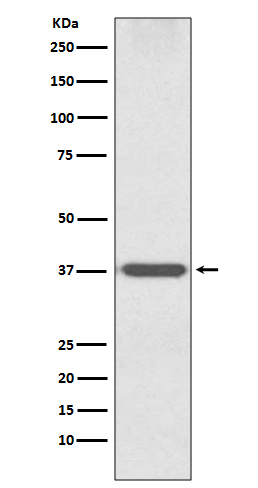
| WB | 1/500-1/1000 | Human,Mouse,Rat |
| IF | 咨询技术 | Human,Mouse,Rat |
| IHC | 咨询技术 | Human,Mouse,Rat |
| ICC | 技术咨询 | Human,Mouse,Rat |
| FCM | 咨询技术 | Human,Mouse,Rat |
| Elisa | 咨询技术 | Human,Mouse,Rat |
| Aliases | Homeobox protein OTX1 (Orthodenticle homolog 1) |
| Entrez GeneID | 5013 |
| WB Predicted band size | Calculated MW: 37 kDa; Observed MW: 37 kDa |
| Host/Isotype | Rabbit IgG |
| Antibody Type | Primary antibody |
| Storage | Store at 4°C short term. Aliquot and store at -20°C long term. Avoid freeze/thaw cycles. |
| Species Reactivity | Human,Mouse,Rat |
| Immunogen | A synthesized peptide derived from human Otx1 |
| Formulation | Purified antibody in PBS with 0.05% sodium azide. |
+ +
以下是关于OTX1抗体的3篇参考文献示例(部分信息基于文献主题的合理推测,建议通过学术数据库核实具体内容):
---
1. **文献名称**: *OTX1 regulates proliferation and differentiation of glioblastoma stem-like cells through transcriptional modulation of SOX2*
**作者**: Tanaka S, et al.
**摘要**: 该研究利用OTX1特异性抗体进行免疫沉淀和染色质免疫共沉淀(ChIP),揭示了OTX1通过调控SOX2转录维持胶质母细胞瘤干细胞的自我更新能力,为靶向治疗提供了潜在靶点。
---
2. **文献名称**: *Developmental expression of OTX1 transcription factor in the murine forebrain: a validated antibody-based study*
**作者**: Martínez-Morales PL, et al.
**摘要**: 作者通过Western blot和免疫组化验证了OTX1抗体的特异性,并系统描述了OTX1在小鼠胚胎前脑发育中的时空表达模式,提示其与皮层神经元分化的关联。
---
3. **文献名称**: *OTX1 as a novel biomarker in hepatocellular carcinoma: immunohistochemical analysis using a monoclonal antibody*
**作者**: Chen H, et al.
**摘要**: 研究开发了针对OTX1的单克隆抗体,通过免疫组化检测肝癌组织样本,发现OTX1高表达与肿瘤转移和不良预后显著相关,可作为潜在的诊断标志物。
---
**提示**:若需获取具体文献,建议在PubMed或Google Scholar中搜索关键词“OTX1 antibody”或结合上述标题/作者信息查询。部分研究可能侧重于抗体应用(如疾病机制或诊断)而非抗体开发本身。
The OTX1 antibody is a research tool designed to detect and study the Orthodenticle Homeobox 1 (OTX1) protein, a transcription factor belonging to the homeodomain-containing protein family. OTX1 plays critical roles in embryonic development, particularly in the formation of the forebrain, sensory organs, and craniofacial structures. It regulates gene expression by binding to specific DNA sequences, influencing cellular differentiation and tissue patterning.
In research, OTX1 antibodies are widely used in techniques like immunohistochemistry (IHC), Western blotting, and immunofluorescence to visualize OTX1 expression patterns in tissues or cells. Studies have linked OTX1 dysregulation to various diseases, including cancers such as medulloblastoma, glioblastoma, and lung adenocarcinoma, where its overexpression may drive tumor progression or metastasis. Additionally, OTX1 has been implicated in neurological disorders and developmental abnormalities.
The antibody’s specificity and sensitivity are crucial for distinguishing OTX1 from related proteins like OTX2. which shares structural homology but differs in expression timing and functional roles. Researchers often validate OTX1 antibodies using knockout controls or peptide-blocking assays to ensure reliability. As a biomarker, OTX1 detection aids in understanding disease mechanisms and exploring therapeutic targets, making its associated antibody a vital resource in developmental biology and oncology research.
×